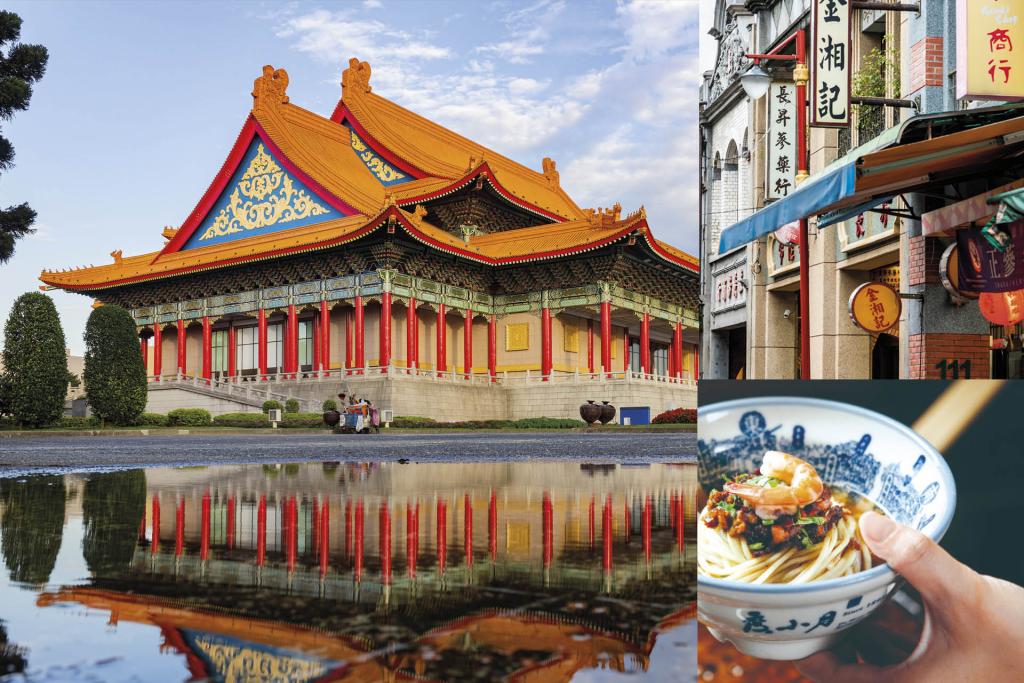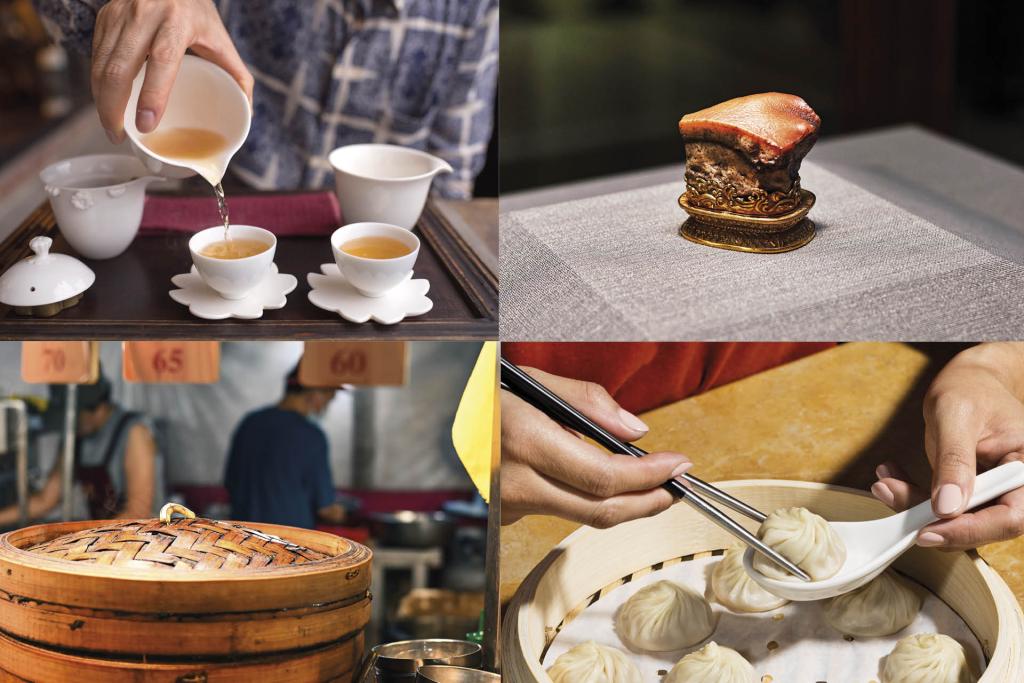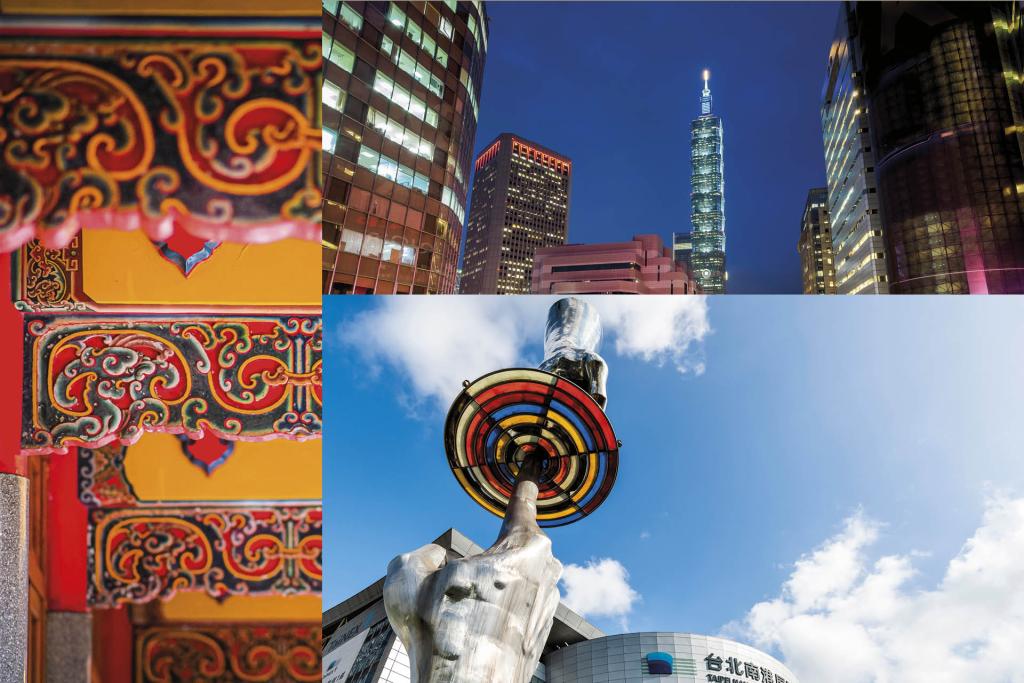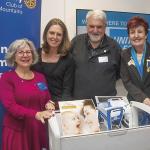The query quest
Why go to Taipei for the 2026 Rotary International Convention? Question asked; question happily answered.
WORDS: Diana Schoberg.
The best part about the red-eye flight to Taipei is that the most magnificent host will welcome you when you arrive: the sun. On the drive from the airport to my hotel, the city’s illustrious landmarks become monumental inkblots when backlit by that blazing orb. As I cruise past rice paddies and riverfront paths, the palatial Grand Hotel, once a haven for foreign dignitaries, salutes me as if I too were visiting royalty, while in the distance, what appears to be an impossibly lofty pagoda – Taipei 101, formerly the world’s tallest building – grandly ascends toward tangerine skies.
I’ve come to Taipei to discover for myself why Rotary members should travel to Taiwan’s capital for the 2026 Rotary International Convention. After reviving myself with a visit to the myriad pools in the steam room and sauna at the Regent Taipei hotel, my quarters in the trendy Zhongshan neighbourhood for the next few days, I set out to answer that question.
I begin by punching ‘coffee’ into the map app on my phone. Half a dozen cafés within blocks of my hotel pop up. Taiwan is known for its oolong teas so I wasn’t sure how easy it would be to find a good cup of coffee, but it turns out Taipei has a thriving coffee culture; even the ubiquitous 7-Elevens serve good coffee, as several of my new Rotary friends tell me later. I choose the Libo café and walk over. The friendly barista helps me choose a drink and giggles right along with me as I tentatively test out a thank you: xiè xiè (pronounced shyeh shyeh).
In Zhongshan, among all the cafés, boutiques and thrift stores, you will find a bounty of luxury shopping. I should have known: My hotel is on a plaza called Fashion Square.
Many years ago, Zhongshan North Road was supposed to be the Champs-Élysées of Taipei,” Pauline Leung, secretary general of the convention’s Host Organisation Committee, tells me a short while later over a lunch of beef noodle soup. “It was the major street where all the prestigious shops were.”
The city has since expanded eastward, as has the city centre, but the neighbourhood has retained its chic reputation.
After lunch, I head out with Pauline and other Rotary members for an afternoon of sightseeing. Our first stop is Liberty Square, a popular spot for concerts, festivals and, in the morning, tai chi. Step outside the National Chiang Kai-Shek Memorial Hall, named after Taiwan’s late leader, and take in the sweeping view of the massive plaza below. Symmetrical garden beds line either side, with red flowers planted in a curved design. Cypress trees with bottlebrush branches stand like sentinels along the border. From this vantage point, the National Theatre is to your left, the National Concert Hall to your right. Both venues, which, with their yellow glazed-tile roofs and red columns, are masterful examples of Chinese palace architecture, will be home to host committee events for the Rotary Convention, 13-17 June.

PICTURED FROM LEFT TTO RIGHT: The National Concert Hal; Dihua Street is Taipei’s oldest street, known for its traditional shops, historic architecture and vibrant atmosphere; Restaurant Du Hsiao Yueh is known for its danzai noodles in a prawn broth with a rich minced pork topping.
“This is a must that all visitors should come see,” insists Pauline.
As we walk across the plaza, Pauline extols Taipei’s charms but expresses regret that it’s a place not many people from the West have seen.
“It’s so different from places that you usually would go,” she says. “It’s just a jewel.” And the Rotary Convention will provide the perfect opportunity for newcomers to admire that precious gem.
Frank Ching-Huei Horng, a Rotary Foundation trustee, has joined us and explains that what keeps him returning to the convention year after year is the opportunity to meet with Rotary members from all over the world.
“Maybe we can find some projects to work on together,” he says. “I love that.”
Frank has made friends with Rotarians from Japan and Korea, and at every convention they search each other out to take photos and have dinner. Their face-to-face meetings may have only an annual cadence, but friendships made at the convention are friendships that last.
Later, Past RI President Gary C.K. Huang reminisces about the 40-plus Rotary Conventions he’s attended in his nearly 50 years as a member of Rotary. He too cherishes the many opportunities to meet so many people of varied cultures and customs.
People will love Rotary more because of this type of cultural exchange,” he says. “That is the special character of Rotary.”
Taipei lies in a basin surrounded by mountains whose hazy outlines make you feel like you’ve landed in a painting. The city grew along the Tamsui River and its tributaries, which encircle much of the city centre. The rivers brought Chinese settlers and European explorers. The island became a colony of Japan in 1895, which it remained through the end of World War II.
You can experience this historical tapestry as you stroll along Dihua Street. Situated in the Dadaocheng neighbourhood, it is the oldest of Taipei’s vibrant ‘old streets’. Chinese settlers arrived here in the mid-1800s and built the earliest trading shops on the street, which runs north-south near the Tamsui River. These older, red brick buildings intermingle with structures from the Japanese colonial era.
The street is closed to vehicles on the weekends, so on the day I visit, Dihua is full of families and tourists milling around, eating and shopping at stores that sell everything from traditional Chinese medicines to fabrics to soaps, bags and countless other goods. The sound of a woman singing floats above the crowd, but it’s soon drowned out by the thump of a drumbeat and a crash of cymbals as a parade for a nearby temple snakes through the throng.
We make stops to visit the Taiyuan Asian Puppet Theatre Museum, which displays traditional and modern Taiwanese hand puppets and marionettes, and the Dadaocheng Visitor Centre, where, by appointment, you can don the traditional clothing and hats lining the room for photo shoots. Even without the costumes, rooms seemingly made for selfies beckon, including one filled with multicoloured lanterns where I couldn’t resist the urge to pull out my camera.
Dinner is at Du Hsiao Yueh, a Dihua restaurant known for its danzai noodles in a prawn broth with a rich minced pork topping. Ping Lee, another of my new Rotary friends, says that one of the best parts about attending a Rotary Convention is exactly what we’re experiencing at this very moment: getting to know a culture from the perspective of a fellow Rotary member.
You get to meet the locals and see how they live,” says Ping, the host committee treasurer. “Each city has something different to offer, which makes it very attractive.” Taipei, she adds, is known for its friendly people – something visiting Rotary members are sure to experience for themselves.
Savour another of Taiwan’s old streets by taking a day trip to Jiufen, a mountain town with stunning views of hills and sea. Turn down an alleyway and you enter a different dimension. Shops line both sides of the narrow brick path, and their overlapping awnings make it feel as if you’re walking through a tunnel, albeit one lit by the warm glow of red lanterns. This former gold mining community is home to more than two dozen teahouses – the Amei Tea House resembles the bathhouse in the Oscar-winning anime movie Spirited Away – and we head down a set of stairs to get a closer look at one of the shops.
Local artist Hung Chi-Sheng has converted the town’s oldest building into Jiufen Teahouse, a gallery featuring pottery, painting and, of course, tea. Charcoal embers nestle safely beneath a hefty wooden table, atop which bubbling teapots billow clouds of steam. One of the staff demonstrates the intricacies of brewing tea and then leaves us to steep our own. More than an hour passes as we sip tea, chat and contemplate the shadowy hills receding into the sea. Once again, the sun becomes the star attraction, casting a sublime pink light before it finally disappears with a sigh.
At the National Palace Museum, you’ll find more than 600,000 pieces of Chinese art and artifacts that span more than 8,000 years, including some 300 items designated as national treasures. You can see scholarly scrolls, elaborately inscribed bronze cookware, and exhibits that trace the development of porcelain techniques. But the piece of art that everyone covets is a drool-inducing rock resembling a chunk of cooked pork that looks ready to eat. An unnamed craftsman carved Meat-Shaped Stone – yes, that’s its name – out of a piece of banded jasper, stained the rock various shades of brown that mimic layers of meat and fat, and created dimples on top to resemble pork skin. The result looks like Dongpo pork, a braised pork belly dish.
While the amazingly realistic stone and its tasty, adjacent bok choy companion, Jadeite Cabbage, may attract the most attention, Beatrice Hui-Shen Liang made sure to show me her favourite work: Lofty Mount Lu, a six-foot-tall scroll painted in 1467 by Shen Zhou.

PICTURED: TOP LEFT: Jiufen is home to more than two dozen teahouses. TOP RIGHT: The Meat-Shaped Stone artwork at the National Palace Museum. Bottom left: Ningxia Night Market is one of nearly 40 night markets in the city. Bottom RIGHT: Din Tai Fung at Taipei 101 is famous for its xiao long bao (soup dumplings).
“I like to show people our Chinese paintings because they’re very, very special,” says Beatrice, whose spouse, Kevin Wen-Ta Liao, is a past district governor and the charter president of the Rotary Club of Taipei Min-Kuan. Beatrice became a volunteer guide at the museum when she returned to her native Taiwan after spending time living in Canada.
“I wanted to learn more about our culture,” says Beatrice, who likes to explain the artwork as seen through the artist’s eyes. “The museum is a treasure,” she concludes, imparting her most important lesson. “It’s not a Chinese treasure; it’s a world treasure. A heritage.”
After I sate my hunger for artifacts, I make my way to the Silks Palace restaurant on the museum grounds to sate my craving for actual food. There, you can order items inspired by pieces in the museum’s collection, including, you guessed it, cabbage and Dongpo pork.
It seems my primary occupation – make that, indulgence – while I’m in Taipei is eating. And now, as the day winds down, I’m back at it again, this time at the Ningxia Night Market, where food stalls line a narrow path jammed with people sampling traditional Taiwanese foods, such as stinky tofu and oyster omelettes.
It’s one of nearly 40 night markets in the city, says Sweetme Shui-Mei Chou, who heads up the Taipei Business District and Industrial Confederation.
Night markets are a very important part of life for locals here in Taiwan and a very popular place to hang out at night,” says Sweetme, a member of the Rotary Club of Taipei Hwa Yueh. Different markets around the city are known for different things, some famous for spicy foods, others for sweets, she explains.
While at the market, I chat with Jackson San-Lien Hsieh, the convention host committee chair and a past RI director and trustee. The hosts, he says, have had a lot of time to prepare for the thousands of Rotary members expected to descend on the city: Taipei’s convention team first made its bid in 2014 and was supposed to host the event in 2021, but the convention went virtual because of the COVID-19 pandemic. For June, the committee has planned extracurricular events that include a run, cycling, symphonic music and opera.
It seems my primary occupation – make that, indulgence – while I’m in Taipei is eating. And now, as the day winds down, I’m back at it again, this time at the Ningxia Night Market, where food stalls line a narrow path jammed with people sampling traditional Taiwanese foods”.
“We have 37,000 Rotary members in Taiwan,” Jackson says. “We’re excited to welcome Rotarians from all over the world.”
As the night winds down, Jackson and Sweetme take me to finish off the long day of sightseeing with a foot massage, a reflexology treatment steeped in Chinese tradition. As I settle comfortably into my chair, my feet and calves are stroked, kneaded, punched and … I’d tell you more, but the session was so relaxing I fell asleep.
Public transit in Taipei is remarkably clean, I’m pleased to notice during my travels the next day. Absolutely no food and beverages are allowed on the Taipei Metro, so take note: Finish that bubble tea before you get on! In addition, people here are expected to take their trash home with them, which is why you will see very few garbage bins on the streets.
Stops on the MRT, as it’s known, are listed in English and Chinese. While that would make it easy for an English speaker like me to navigate the Metro alone, today I have Eric Chiu showing me around the city.
Eric, 44, runs a lifestyle media company and looks the fashionable part. When the Rotary Club of Taipei Generation Next was founded in 2011 as an alternative for younger people in the city, the club members were on average in their 30s, and Eric, as the son of a Rotarian, was charter president.
“They kind of tricked me into it,” he jokes, “and then 10 years pass by.”
It’s like a fast-motion review of all the marvellous places I explored, all the wonderful people that I met – which, now that I think about it, are the answer to my question about why Rotary members should travel to Taipei for the 2026 convention”.
We make a quick stop at Xingtian Temple, one of the most visited temples in Taiwan. Folk beliefs that combine Confucianism, Buddhism and Taoism are most common in Taiwan, and this temple is devoted to Guan Gong, a deified real-life military general. Eric joins the masses of people bowing and praying inside the temple, and then we grab lunch and a mango shaved ice for dessert, which turns out to be my own little piece of heaven. Scraped in thin layers as it’s served into a bowl, it looks like a mango orange flower.
Refreshed, we head back to the MRT and make our way to the Taipei Dome, an indoor baseball stadium and concert venue that opened in 2023. It will be home to the opening and closing sessions for the Rotary Convention; other sessions and the House of Friendship will convene at the Taipei Nangang Exhibition Centre, a short ride from the dome on the MRT (transit passes are included with your convention registration).
The Taipei Dome’s glistening titanium facade provides an interesting juxtaposition to the neighbouring historical Songshan Cultural and Creative Park, a refurbished cigarette-rolling factory that houses the Taiwan Design Museum and a hip collection of galleries and shops. Eric owns one of them, Everyday Object, which sells coffee, books, household items, games and more. Within the park you will find a hidden courtyard and fountain, behind which rises the dome and the Taipei skyline.

PICTURED: LEFT: Ceiling art in Xingtian Temple. TOP RIGHT: The iconic Taipei 101. RIGHT BELOW: The House of Friendship will convene at the Taipei Nangang Exhibition Centre.
I think every single individual can find something they would really love about this city,” Eric says. “That’s the most special thing about Taipei.”
I’ve written a lot about Rotary’s work on water and sanitation, and I live with a tween – or maybe it’s just that, on the inside, I’m still 12 years old. That said, I couldn’t pass up a chance to drop into a restaurant called Modern Toilet once Eric and I say our goodbyes.
Tucked into the Ximending shopping district, the restaurant uses toilets as stools and serving dishes. My bubble tea was in a miniature urinal, and for dessert I had a big pile of chocolate ice cream in a squat toilet. The novelty of the place, and the yummy photo ops, left me flush (sorry) with joy.
This is it, the moment I’ve been dreading my whole trip. It’s my last day in Taipei, and it’s time to make my way up Taipei 101.
I’m not typically one for elevators and heights – but I’m also not typically one to turn down an adventure. So, after some gentle encouragement, promises that someone will hold my hand if I freak out, and a gut-busting serving of xiao long bao (soup dumplings) at Din Tai Fung on the skyscraper’s ground floor, I step into the elevator.
As the elevator climbs from the fifth to the 89th floor, a digital sign tells you how fast you’re going as well other statistics. Or so I’m told: I couldn’t bear to look. But I barely have time to get nervous before we complete our trip and the doors open; the ride takes only 37 seconds, reaching a top speed of approximately 60 kilometres per hour. This was without question the smoothest elevator ride I’ve ever taken. I exhale in relief and step out.
I’m glad I conquered my fear. From this height I can see the outlines of Taipei’s basin, the mountains rising in the distance. The roofs of the buildings in Liberty Square, the gleaming silver Taipei Dome. It’s like a fast-motion review of all the marvellous places I explored, all the wonderful people that I met – which, now that I think about it, are the answer to my question about why Rotary members should travel to Taipei for the 2026 convention.
I also see things I didn’t have time to visit. I wish I had more time so I could hike at Yangmingshan National Park, take a gondola to see the tea plantations in Maokong, stay at the Grand Hotel, and shop at more of the night markets. This might be the sunset of my time in Taipei, but the sun will come back and, undoubtedly, so will I.
Related news
2025 Zone 8 Conference a resounding success
What an amazing weekend we had at the Zone 8 Conference in Coolangatta, Qld, from 31 October to 2 November 2025.
The surprising science behind why people say no to joining Rotary
Rotary growth depends on connection, trust and empathy – because people join people, not just clubs or causes.
Commonwealth colleagues collaborate to end polio
Polio Moose debuts at the 2025 Calgary Convention, raising funds and awareness to help Rotary end polio worldwide.
Join our newsletter for the latest updates
"*" indicates required fields


